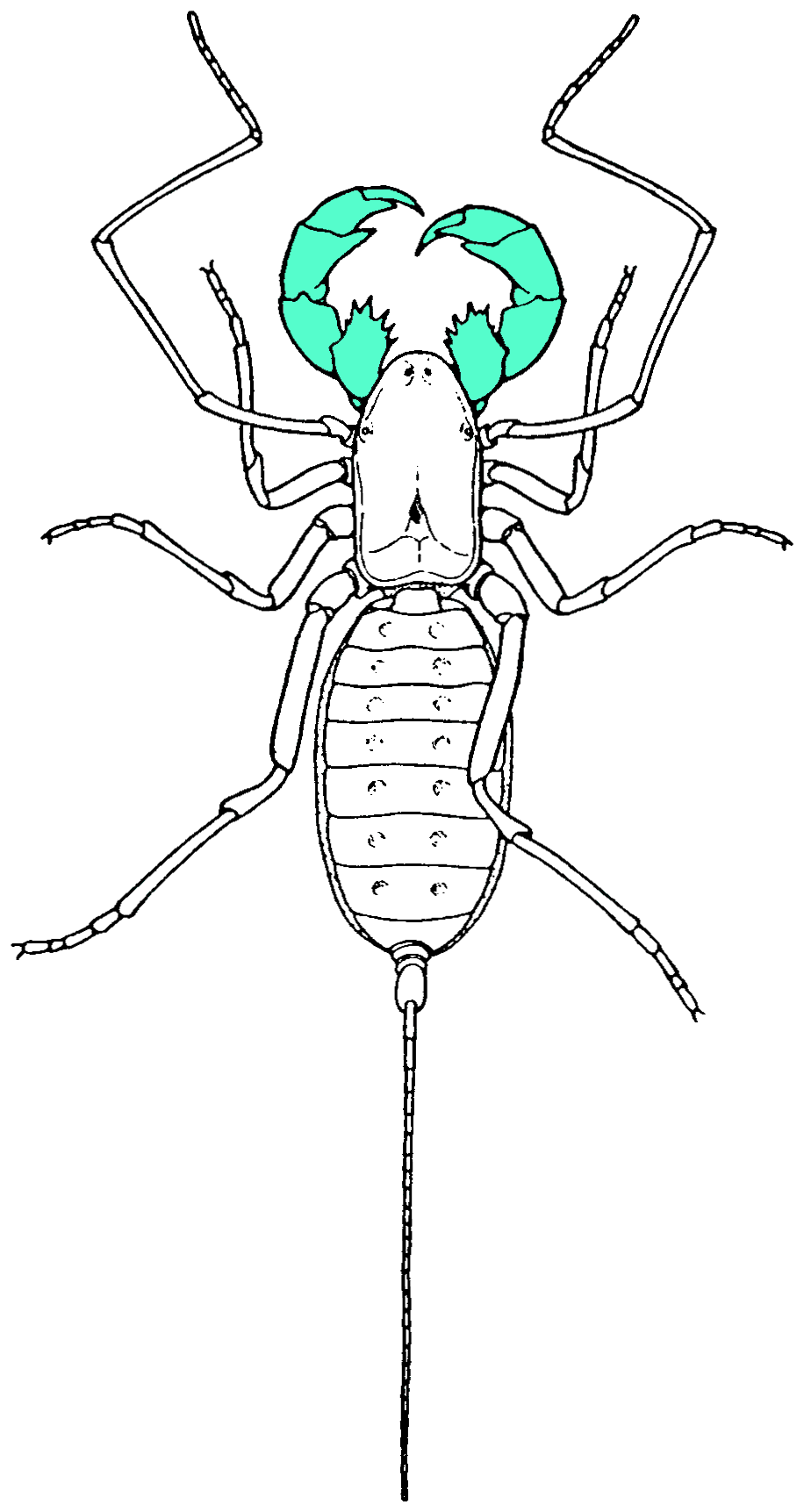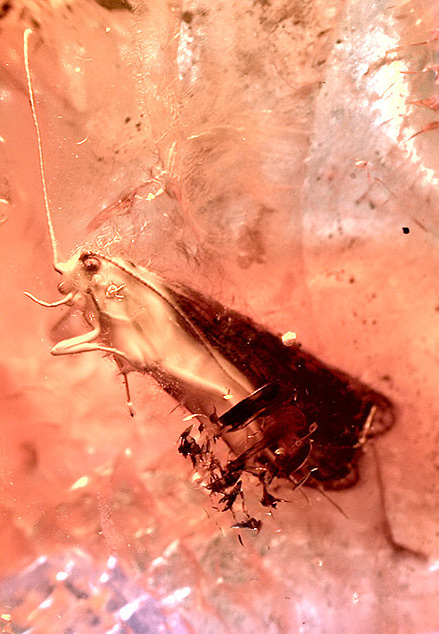|
Rakiura (insect)
''Rakiura'' is a genus of Trichoptera (caddisfly). The genus contains only one species, ''Rakiura vernale'', which is Endemism, endemic to New Zealand. ''Rakiura vernale'' represents the most basal (phylogenetics), basal taxon within the Helicopsychidae. Identification Larvae have a case that is dextrally coiled, with the coils incompletely fused. The head, in dorsal view, is rounded with marginal wikt:carina, carina and covered by loosely distribute setae. The posterior part of frontoclypeal is slender. In lateral view, the head is dorsally straight with eyes erected dorsad. Larvae have a strongly sclerotized pronotum with anterior-pointing megasetae. The mesonotum and metanotum are weakly sclerotized. No abdominal gills are present. An anal claw is present with a single row of comb-shaped accessory hooks. Adults have 2-jointed maxillary palps, a basal joint with strong median setae, and a distal joint about 2,5 times longer than basal joint. Antenna (biology), Antennae are ... [...More Info...] [...Related Items...] OR: [Wikipedia] [Google] [Baidu] |
Genus
Genus (; : genera ) is a taxonomic rank above species and below family (taxonomy), family as used in the biological classification of extant taxon, living and fossil organisms as well as Virus classification#ICTV classification, viruses. In binomial nomenclature, the genus name forms the first part of the binomial species name for each species within the genus. :E.g. ''Panthera leo'' (lion) and ''Panthera onca'' (jaguar) are two species within the genus ''Panthera''. ''Panthera'' is a genus within the family Felidae. The composition of a genus is determined by taxonomy (biology), taxonomists. The standards for genus classification are not strictly codified, so different authorities often produce different classifications for genera. There are some general practices used, however, including the idea that a newly defined genus should fulfill these three criteria to be descriptively useful: # monophyly – all descendants of an ancestral taxon are grouped together (i.e. Phylogeneti ... [...More Info...] [...Related Items...] OR: [Wikipedia] [Google] [Baidu] |
Mesonotum
The mesothorax is the middle of the three segments of the thorax of hexapods, and bears the second pair of legs. Its principal sclerites (exoskeletal plates) are the mesonotum (dorsal), the mesosternum ( ventral), and the mesopleuron (lateral) on each side. The mesothorax is the segment that bears the forewings in all winged insects, though sometimes these may be reduced or modified, as in beetles ( Coleoptera) or Dermaptera, in which they are sclerotized to form the elytra ("wing covers"), and the Strepsiptera, in which they are reduced to form halteres that attach to the mesonotum. All adult insects possess legs on the mesothorax. In some groups of insects, the mesonotum is hypertrophied, such as in Diptera, Hymenoptera, and Lepidoptera), in which the anterior portion of the mesonotum (called the mesoscutum, or simply "scutum") forms most of the dorsal surface of the thorax. In these orders, there is also typically a small sclerite attached to the mesonotum that covers t ... [...More Info...] [...Related Items...] OR: [Wikipedia] [Google] [Baidu] |
Integripalpia
The Integripalpia are a suborder of Trichoptera, the caddisflies. The name refers to the unringed nature of maxillary palp's terminal segment in the adults. Integripalpian larvae construct portable cases out of debris during the first larval instar, which are enlarged through subsequent instars. These cases are often very specific in construction at both the family and genus level. External linksTree Of Life Integripalpia Page Integripalpia, Insect suborders {{Trichoptera-stub ... [...More Info...] [...Related Items...] OR: [Wikipedia] [Google] [Baidu] |
Endemic Fauna Of New Zealand
Endemism is the state of a species being found only in a single defined geographic location, such as an island, state, nation, country or other defined zone; organisms that are indigenous to a place are not endemic to it if they are also found elsewhere. For example, the Cape sugarbird is found exclusively in southwestern South Africa and is therefore said to be ''endemic'' to that particular part of the world. An endemic species can also be referred to as an ''endemism'' or, in scientific literature, as an ''endemite''. Similarly, many species found in the Western ghats of India are examples of endemism. Endemism is an important concept in conservation biology for measuring biodiversity in a particular place and evaluating the risk of extinction for species. Endemism is also of interest in evolutionary biology, because it provides clues about how changes in the environment cause species to undergo range shifts (potentially expanding their range into a larger area or becomin ... [...More Info...] [...Related Items...] OR: [Wikipedia] [Google] [Baidu] |
Antenna (biology)
An antenna (plural: antennae) is one of a pair of appendages used for Sensory system, sensing in arthropods. Antennae are sometimes referred to as ''feelers''. Antennae are connected to the first one or two Segmentation (biology), segments of the arthropod head. They vary widely in form but are always made of one or more jointed segments. While they are typically sensory organs, the exact nature of what they sense and how they sense it is not the same in all groups. Functions may variously include sensing tactition, touch, air motion, heat, vibration (sound), and especially insect olfaction, smell or gustation, taste. Antennae are sometimes modified for other purposes, such as mating, brooding, swimming, and even anchoring the arthropod to a substrate (biology), substrate. Larval arthropods have antennae that differ from those of the adult. Many crustaceans, for example, have free-swimming larvae that use their antennae for swimming. Antennae can also locate other group members i ... [...More Info...] [...Related Items...] OR: [Wikipedia] [Google] [Baidu] |
Palps
Pedipalps (commonly shortened to palps or palpi) are the secondary pair of forward appendages among chelicerates – a group of arthropods including spiders, scorpions, horseshoe crabs, and sea spiders. The pedipalps are lateral to the chelicerae ("jaws") and anterior to the first pair of walking legs. Overview Pedipalps are composed of six segments or articles. From the proximal end (where they are attached to the body) to the distal, they are: the coxa, the trochanter, the femur, the short patella, the tibia, and the tarsus. In spiders, the coxae frequently have extensions called maxillae or gnathobases, which function as mouth parts with or without some contribution from the coxae of the anterior legs. The limbs themselves may be simple tactile organs outwardly resembling the legs, as in spiders, or chelate weapons (pincers) of great size, as in scorpions. The pedipalps of Solifugae are covered in setae, but have not been studied in detail. Comparative studies of pedipalpa ... [...More Info...] [...Related Items...] OR: [Wikipedia] [Google] [Baidu] |
Maxilla
In vertebrates, the maxilla (: maxillae ) is the upper fixed (not fixed in Neopterygii) bone of the jaw formed from the fusion of two maxillary bones. In humans, the upper jaw includes the hard palate in the front of the mouth. The two maxillary bones are fused at the intermaxillary suture, forming the anterior nasal spine. This is similar to the mandible (lower jaw), which is also a fusion of two mandibular bones at the mandibular symphysis. The mandible is the movable part of the jaw. Anatomy Structure The maxilla is a paired bone - the two maxillae unite with each other at the intermaxillary suture. The maxilla consists of: * The body of the maxilla: pyramid-shaped; has an orbital, a nasal, an infratemporal, and a facial surface; contains the maxillary sinus. * Four processes: ** the zygomatic process ** the frontal process ** the alveolar process ** the palatine process It has three surfaces: * the anterior, posterior, medial Features of the maxilla include: * t ... [...More Info...] [...Related Items...] OR: [Wikipedia] [Google] [Baidu] |
Gills
A gill () is a respiratory organ that many aquatic organisms use to extract dissolved oxygen from water and to excrete carbon dioxide. The gills of some species, such as hermit crabs, have adapted to allow respiration on land provided they are kept moist. The microscopic structure of a gill presents a large surface area to the external environment. Branchia (: branchiae) is the zoologists' name for gills (from Ancient Greek ). With the exception of some aquatic insects, the filaments and lamellae (folds) contain blood or coelomic fluid, from which gases are exchanged through the thin walls. The blood carries oxygen to other parts of the body. Carbon dioxide passes from the blood through the thin gill tissue into the water. Gills or gill-like organs, located in different parts of the body, are found in various groups of aquatic animals, including molluscs, crustaceans, insects, fish, and amphibians. Semiterrestrial marine animals such as crabs and mudskippers have gill chamber ... [...More Info...] [...Related Items...] OR: [Wikipedia] [Google] [Baidu] |
Abdominal
The abdomen (colloquially called the gut, belly, tummy, midriff, tucky, or stomach) is the front part of the torso between the thorax (chest) and pelvis in humans and in other vertebrates. The area occupied by the abdomen is called the abdominal cavity. In arthropods, it is the posterior tagma of the body; it follows the thorax or cephalothorax. In humans, the abdomen stretches from the thorax at the thoracic diaphragm to the pelvis at the pelvic brim. The pelvic brim stretches from the lumbosacral joint (the intervertebral disc between L5 and S1) to the pubic symphysis and is the edge of the pelvic inlet. The space above this inlet and under the thoracic diaphragm is termed the abdominal cavity. The boundary of the abdominal cavity is the abdominal wall in the front and the peritoneal surface at the rear. In vertebrates, the abdomen is a large body cavity enclosed by the abdominal muscles, at the front and to the sides, and by part of the vertebral column at the back. Low ... [...More Info...] [...Related Items...] OR: [Wikipedia] [Google] [Baidu] |
Metanotum
The metathorax is the posterior of the three segments in the thorax of an insect, and bears the third pair of legs. Its principal sclerites ( exoskeletal plates) are the metanotum (dorsal), the metasternum ( ventral), and the metapleuron (lateral Lateral is a geometric term of location which may also refer to: Biology and healthcare * Lateral (anatomy), a term of location meaning "towards the side" * Lateral cricoarytenoid muscle, an intrinsic muscle of the larynx * Lateral release ( ...) on each side. The metathorax is the segment that bears the hindwings in most winged insects, though sometimes these may be reduced or modified, as in the flies ( Diptera), in which they are reduced to form halteres, or flightless, as in beetles ( Coleoptera), in which they may be completely absent even though forewings are still present. All adult insects possess legs on the metathorax. In most groups of insects, the metanotum is reduced relative to the mesonotum. In the suborder Ap ... [...More Info...] [...Related Items...] OR: [Wikipedia] [Google] [Baidu] |
Trichoptera
The caddisflies (order Trichoptera) are a group of insects with aquatic larvae and terrestrial adults. There are approximately 14,500 described species, most of which can be divided into the suborders Integripalpia and Annulipalpia on the basis of the adult mouthparts. Integripalpian larvae construct a portable casing to protect themselves as they move around looking for food, while annulipalpian larvae make themselves a fixed retreat in which they remain, waiting for food to come to them. The affinities of the small third suborder Spicipalpia are unclear, and Molecular phylogenetics, molecular analysis suggests it may not be monophyletic. Also called sedge-flies or rail-flies, the adults are small moth-like insects with two pairs of hairy membranous insect wing, wings. They are closely related to the Lepidoptera (moths and butterflies) which have scales on their wings; the two orders together form the superorder Amphiesmenoptera. The aquatic larvae are found in a wide variety o ... [...More Info...] [...Related Items...] OR: [Wikipedia] [Google] [Baidu] |







